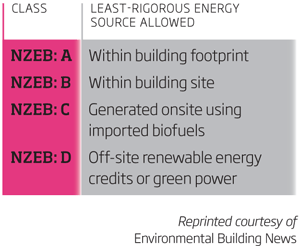Targeting Net-Zero
Net-Zero Development
| Benchmarking Performance |
Classifying Net-Zero for Codes and Standards Recognizing the increasing move toward policies and codes prescribing zero-energy buildings and communities, researchers at the National Renewable Energy Lab (NREL) and the U.S. Department of Energy have helped define the terms for policymakers in specific, potentially enforceable language. They began in 2006, in the report "Zero Energy Buildings: A Critical Look at the Def-initions," which argues that net-zero energy can be calculated on the basis of site energy, source energy, energy cost, or greenhouse gas emissions. There are pros and cons to each, but basing net-zero on emissions is the least rigorous approach: a project could conceivably buy carbon offsets to claim net-zero emissions or "carbon neutral" status without more directly reducing its footprint. They followed that up with a June 2010 report where they describe four "classes" of net-zero-energy buildings (nzeb) based on where the renewable energy they use originates:  Source: Shanti Pless and Paul Torcellini, "Net-Zero Energy Buildings: A Classification System Based on Renewable Energy Supply Options" NREL/TP-550-44586
|
Since some buildings are currently impractical to balance and others are potential net producers, it makes sense that designers and planners scale-up to net-zero developments, communities, even cities.Â
The aptly named town of Greensburg, Kansas, presents an unusual opportunity born out of tragedy. After the small town was flattened by a powerful tornado in 2007, the town council passed a resolution to rebuild it to LEED Platinum standards. They hired Kansas City firm BNIM to work on the master plan for the project. In addition to civic buildings such as schools, a city hall, and museums, BNIM principal Bob Berkebile, FAIA, says that the residences are being built to use half the energy of the houses they are replacing.
"What's always the same [in sustainable design] is really knowing the climate and ecology of the place and designing to it-that's the main act on my part," Berkebile comments. "The decision after that point is simple-it's choosing the best renewable energy source available." In the case of Greensburg, wind energy is plentiful. Berkebile points to the bittersweet irony that "the force that tore the town apart is being used to power it in the future." With its substantial wind farm, the town will be a net energy producer. BNIM is also working on two other net-zero master plans for Chatham College in Pittsburgh and Oberlin College in Oberlin, Ohio.
The Chinese are producing schemes to test the concept of net-zero development on a grand scale. The Australian-based firm Woods Bagot is working with engineers Buro Happold on a 4-million-square-foot mixed-use development in Chongqing.
"There's an efficiency of scale in a project of this size," Woods Bagot chair Ross Donaldson says of the web of systems that would form an "eco-infrastructure." The emphasis is on zero-carbon/zero-emissions and takes a comprehensive approach to sustainability with integrated systems for zero energy, air quality, and waste recycling.
The role of Net-Zero
The spike of creativityand new technology for developing net-zero energy illustrates the urgent need to address climate change and shrinking supplies of fossil fuels. Lawrence Berkley Lab's Selkowitz asserts that we aren't yet at the point where net-zero performance is scalable to U.S. buildings. "What's important about net-zero is to drive the intrinsic energy use as low as possible-50 to 80 percent range. If you do that, you're in good shape," he adds.
But radical goals, such as sending humans to the moon, spur new ways of thinking and often generate technologies and concepts that transcend their intended purpose. Which brings us back to the refrigerator. Ramping up awareness, technology, and major policy shifts may be the only way to keep our heads above water.Â








